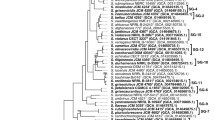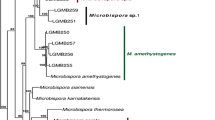Abstract
The family Streptomycetaceae, notably species in the genus Streptomyces, have long been the subject of investigation due to their well-known ability to produce secondary metabolites. The emergence of drug resistant pathogens and the relative ease of producing genome sequences has renewed the importance of Streptomyces as producers of new natural products and resulted in revived efforts in isolating and describing strains from novel environments. A previous large study of the phylogeny in the Streptomycetaceae based on 16S rRNA gene sequences provided a useful framework for the relationships among species, but did not always have sufficient resolution to provide definitive identification. Multi-locus sequence analysis of 5 house-keeping genes has been shown to provide improved taxonomic resolution of Streptomyces species in a number of previous reports so a comprehensive study was undertaken to evaluate evolutionary relationships among species within the family Streptomycetaceae where type strains are available in the ARS Culture Collection or genome sequences are available in GenBank. The results of the analysis supported the distinctiveness of Kitasatospora and Streptacidiphilus as validly named genera since they cluster outside of the phylogenetic radiation of the genus Streptomyces. There is also support for the transfer of a number of Streptomyces species to the genus Kitasatospora as well for reducing at least 31 species clusters to a single taxon. The multi-locus sequence database resulting from the study is a useful tool for identification of new isolates and the phylogenetic analysis presented also provides a road map for planning future genome sequencing efforts in the Streptomycetaceae.










Similar content being viewed by others
Abbreviations
- DDH:
-
DNA–DNA hybridization
References
Gauze GF, Preobrazhenskaya TP, Sveshnikova MA, Terekhova LP, Maximova TS (1983) A guide for the determination of actinomycetes. Genera Streptomyces, Streptoverticillium and Chainia. Nauka, Moscow
Girard G, Willemse J, Zhu H, Claessen D, Bukarasam K, Goodfellow M, van Wezel GP (2014) Analysis of novel kitasatosporae reveals significant evolutionary changes in conserved developmental genes between Kitasatospora and Streptomyces. Antonie Van Leeuwenhoek 106:365–380
Guindon S, Dufayard J-F, Lefort V, Anisimova M, Hordijk W, Gascuel O (2010) New algorithms and methods to estimate maximum-likelihood phylogenies: assessing the performance of PhyML 3.0. Syst Biol 59:307–321
Guo Y, Zheng W, Rong X, Huang Y (2008) A multi-locus phylogeny of the Streptomyces griseus 16S rRNA gene clade: use of multi-locus sequence analysis for streptomycete systematics. Int J Syst Evol Microbiol 58:149–159
Hatano K, Nishii T, Mordarska H et al (1997) Streptomyces spitsbergensis Wieczorek et al. 1993 is a later subjective synonym of Streptomyces baldaccii (Farina and Locci 1966) Witt and Stackebrandt 1991. Int J Syst Bacteriol 47:573–574
Huang M-J, Rao MPN, Salam N, Xiao M, Huang H-Q, Li W-J (2016) Allostreptomyces psammosilenae gen. nov., sp. nov., an endophytic actinobacterium isolated from the roots of Psammosilene tunicoides and emended description of the family Streptomycetaceae (Waksman and Henrici (1943)AL) emend. Rainey et al. 1997, emend. Kim et al. 2003, emend. Zhi et al. 2009. Int J Syst Evol Microbiol. doi:10.1099/ijsem.0.001617
Jolley K, Maiden M (2010) BIGSdb: scalable analysis of bacterial genome variation at the population level. BMC Bioinform 11:595
Kämpfer P (2012) Family I Streptomycetaceae Waksman and Henrici 1943, 339AL emend. Rainey, Ward-Rainey and Stackebrandt 1197, 486 emend. Kim, Lonsdale, Seong and Goodfellow 2003B, 113 emend. Zhi, Li and Stackebrandt 2009, 600. In: Goodfellow M, Kampfer P, Busse H-J, Trujillo M, Suzuki KE, Ludwig W, Whitman WB (eds) Bergey’s manual of systematic bacteriology, vol 5, 2nd edn. Springer, New York, pp 1446–1447
Katoh K, Standley DM (2013) MAFFT multiple sequence alignment software version 7: improvements in performance and usability. Mol Biol Evol 30:772–780
Kimura M (1980) A simple method for estimating evolutionary rate of base substitutions through comparative studies of nucleotide sequences. J Mol Evol 16:111–120
Labeda DP (2016) Taxonomic evaluation of putative Streptomyces scabiei strains held in the ARS Culture Collection (NRRL) using multi-locus sequence analysis. Antonie Van Leeuwenhoek 109:349–356
Labeda DP, Goodfellow M, Brown R, Ward AC, Lanoot B, Vanncanneyt M, Swings J, Kim S-B, Liu Z, Chun J, Tamura T, Oguchi A, Kikuchi T, Kikuchi H, Nishii T, Tsuji K, Yamaguchi Y, Tase A, Takahashi M, Sakane T, Suzuki KI, Hatano K (2012) Phylogenetic study of the species within the family Streptomycetaceae. Antonie Van Leeuwenhoek 101:73–104
Labeda DP, Doroghazi JP, Ju K-S, Metcalf WW (2014) Taxonomic evaluation of Streptomyces albus and related species using multi-locus sequence analysis and proposals to emend the description of Streptomyces albus and describe Streptomyces pathocidini sp. nov. Int J Syst Evol Microbiol 64:894–900
Labeda DP, Rong X, Huang Y, Doroghazi JR, Ju K-S, Metcalf WM (2016) Taxonomic evaluation of species in the Streptomyces hirsutus clade using multi-locus sequence analysis and proposals to reclassify several species in this clade. Int J Sys Evol Microbiol 66:2444–2450
Lanoot B, Vancanneyt M, Cleenwerck I, Wang L, Li W, Liu Z, Swings J (2002) The search for synonyms among streptomycetes by using SDS-PAGE of whole-cell proteins. Emendation of the species Streptomyces aurantiacus, Streptomyces cacaoi subsp. cacaoi, Streptomyces caeruleus and Streptomyces violaceus. Int J Syst Evol Microbiol 52:823–829
Lanoot B, Vancanneyt M, Dawyndt P, Cnockaert M, Zhang J, Huang Y, Liu Z, Swings J (2004) BOX-PCR fingerprinting as a powerful tool to reveal synonymous names in the genus Streptomyces. Emended descriptions are proposed for the species Streptomyces cinereorectus, S. fradiae, S. tricolor, S. colombiensis, S. filamentosus, S. vinaceus and S. phaeopurpureus. Syst Appl Microbiol 27:84–92
Lanoot B, Vancanneyt M, Van Schoor A, Liu Z, Swings J (2005) Reclassification of Streptomyces nigrifaciens as a later synonym of Streptomyces flavovirens; Streptomyces citreofluorescens, Streptomyces chrysomallus subsp. chrysomallus and Streptomyces fluorescens as later synonyms of Streptomyces anulatus; Streptomyces chibaensis as a later synonym of Streptomyces corchorusii; Streptomyces flaviscleroticus as a later synonym of Streptomyces minutiscleroticus; and Streptomyces lipmanii, Streptomyces griseus subsp. alpha, Streptomyces griseus subsp. cretosus and Streptomyces willmorei as later synonyms of Streptomyces microflavus. Int J Syst Evol Microbiol 55:729–731
Minh BQ, Nguyen MAT, von Haeseler A (2013) Ultrafast approximation for phylogenetic bootstrap. Mol Biol Evol 30:1188–1195
Nei M, Kumar S (2000) Molecular evolution and phylogenetics. Oxford University Press, New York
Nguyen L-T, Schmidt HA, von Haeseler A, Minh BQ (2015) IQ-TREE: a fast and effective stochastic algorithm for estimating maximum likelihood phylogenies. Mol Biol Evol 32:268–274
Price NP, Labeda DP, Naumann TA, Vermillion KE, Bowman MJ, Berhow MA, Metcalf WW, Bischoff KM (2016) Quinovosamycins: new tunicamycin-type antibiotics in which the α, β-1″,11′-linked N-acetylglucosamine residue is replaced by N-acetylquinovosamine. J Antibiotics 69:637–646
Rong X, Huang Y (2010) Taxonomic evaluation of the Streptomyces griseus clade using multilocus sequence analysis and DNA-DNA hybridization, with proposal to combine 29 species and three subspecies as 11 genomic species. Int J Syst Evol Microbiol 60:696–703
Rong X, Huang Y (2012) Taxonomic evaluation of the Streptomyces hygroscopicus clade using multi-locus sequence analysis and DNA-DNA hybridization, validating the MLSA scheme for the systematics of the whole genus. Syst Appl Microbiol 35:7–18
Rong X, Huang Y (2014) Multilocus sequence analysis: taking prokaryote systematics to the next level, Chapter 11. In: Goodfellow M, Sutcliffe I, Chun J (eds) Methods in microbiology, volume 41. New approaches to prokaryote systematics. Elsevier, London, pp 221–251
Rong X, Gou Y, Huang Y (2009) Proposal to reclassify the Streptomyces albidoflavus clade based on the basis of multi-locus sequence analysis and DNA-DNA hybridization, and taxonomic elucidation of Streptomyces griseus subsp. solvifaciens. Syst Appl Microbiol 32:314–322
Rong X, Liu N, Ruan J, Huang Y (2010) Multilocus sequence analysis of Streptomyces griseus isolates delineating intraspecific diversity in terms of both taxonomy and biosynthetic potential. Antonie van Leeuenhoek 98:237–248
Saitou N, Nei M (1987) The neighbor-joining method: a new method for reconstructing phylogenetic trees. Mol Biol Evol 4:406–425
Shirling E, Gottlieb DA (1966) Methods for characterization of Streptomyces species. Int J Syst Bacteriol 16:313–340
Shirling E, Gottlieb DA (1972) Cooperative description of type strains of Streptomyces. V. Additional descriptions. Int J Syst Bacteriol 22:265–394
Tamura T, Ishida Y, Otoguro M, Hatano K, Labeda D, Price NP, Suzuki K (2008) Reclassification of Streptomyces caeruleus as a synonym of Actinoalloteichus cyanogriseus and reclassification of Streptomyces spheroides and Streptomyces laceyi as later synonyms of Streptomyces niveus. Int J Syst Evol Microbiol 58:2812–2814
Tamura K, Stecher G, Peterson D, Filipski A, Kumar S (2013) MEGA6: molecular evolutionary genetics analysis version 6.0. Mol Biol Evol 30:2725–2729
Williams ST, Goodfellow M, Alderson G, Wellington EMH, Sneath PHA, Sackin MJ (1983) Numerical classification of Streptomyces and related genera. J Gen Microbiol 129:1743–1813
Acknowledgements
The able technical assistance of E. Basehoar in determining the house keeping gene sequences and A. McGovern and H. Walker in determining draft genome sequences is gratefully acknowledged. Mention of trade names or commercial products in this publication is solely for the purpose of providing specific information and does not imply recommendation or endorsement by the U.S. Department of Agriculture. USDA is an equal opportunity provider and employer. DPL and the ARS Culture Collection CRIS project was supported by ARS National Program 301. CAD was supported by ARS National Program 206. XR and YH were supported partially by the Specialized Research Fund for State Key Laboratories of China. WWM was supported by the National Institutes of Health (GM PO1 GM077596). JRD was funded by an Institute for Genomic Biology Postdoctoral Fellowship. KSJ was funded by an NIH NRSA Postdoctoral Fellowship (GM100658).
Author information
Authors and Affiliations
Corresponding author
Electronic supplementary material
Below is the link to the electronic supplementary material.
Rights and permissions
About this article
Cite this article
Labeda, D.P., Dunlap, C.A., Rong, X. et al. Phylogenetic relationships in the family Streptomycetaceae using multi-locus sequence analysis. Antonie van Leeuwenhoek 110, 563–583 (2017). https://doi.org/10.1007/s10482-016-0824-0
Received:
Accepted:
Published:
Issue Date:
DOI: https://doi.org/10.1007/s10482-016-0824-0




